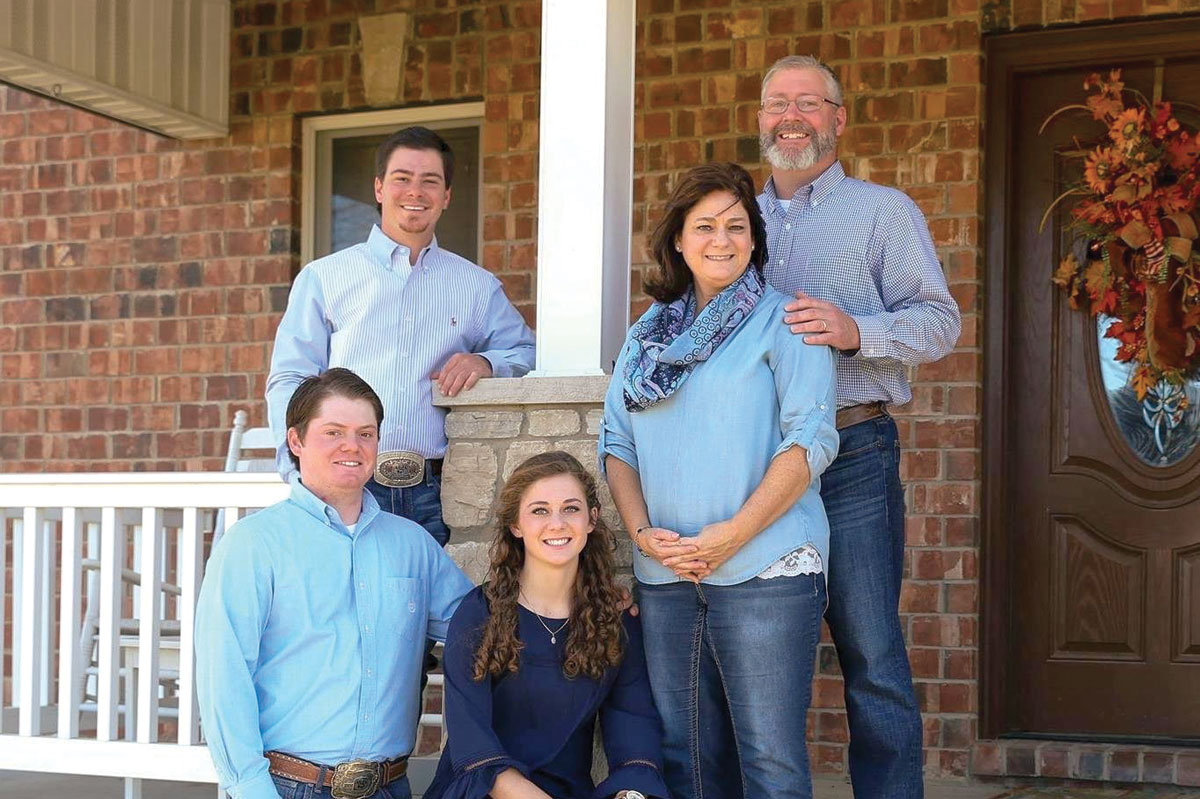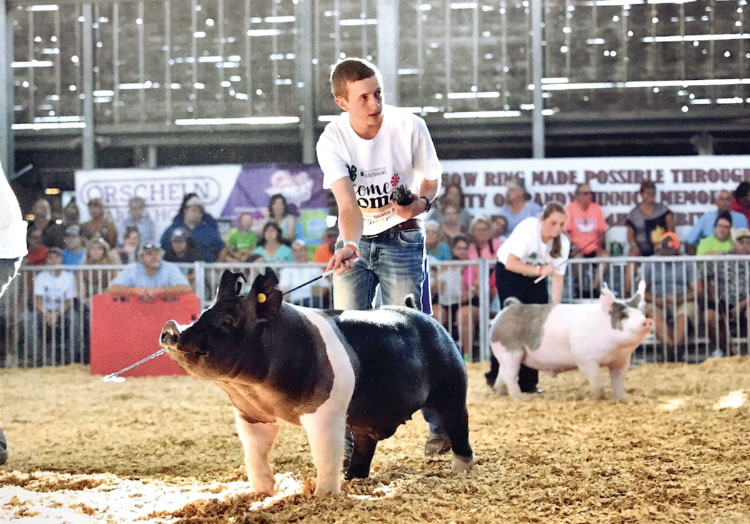
The Vehige family moved their seedstock operation to the Ozarks with plans for future growth
T Bar S Cattle Company in Billings, Mo., may be new to the Ozarks, but the Vehige family isn’t new to the cattle industry or the Gelbvieh breed.
Tom Vehige, along with his wife Stacy and their children, moved their cattle operation from Frankenstein, Mo., in February after Tom, the vice president of commercial livestock in Southwest Missouri for Farm Credit Services Financial, was asked to relocate to the region.
“I had the opportunity to incorporate what I love and how I make a living off the farm,” Tom said. “It’s allowed me to do what I’ve grown up doing and am passionate about with what I’ve done to support my passion and family for the last 30 years.”
The family purchased a 140-acre farm in Christian County, Mo., and are planning for the future.
“Southwest Missouri is cow country,” Tom said. “It’s pretty obvious if you talk to my kids very long that we’re cattle people. For the first time in my life, I feel things have gone my way.”
“We’ve waited a lifetime to be able to do this for our kids (Justin, Kyle and Grace),” Stacy added. “It was hard to leave family, friends and a lifetime there, but we knew if our kids wanted a future in agriculture we have to be a part of it with them. All three of our kids want to be a part of agriculture, so why not provide them with the opportunity?”
Raising high-quality cattle is the goal of the Vehige family. They currently have about 70 head of Gelbvieh and Balancers.
Tom grew up with commercial cattle and when he and Stacy got married, Tom decided he wanted to get his own set of cows. After some research, the docility, structure, maternal quality, muscle and power of the breed drew Tom to Gelbvieh.
“I told (Stacy) if I couldn’t get as many as I wanted, I wanted to get the best I could. We’ve spent 25 years building that. It’s gratifying to see your children have some success with that you’ve grown,” Tom said. “I don’t know how many years or shows it’s been, but we’ve been blessed to have the success we have with our cattle.”
The Vehige family has won a number of titles with both bulls and heifers, but they aren’t focused strictly on the show industry.
“A good motto that we have is to turn a cow into a show heifer and a show heifer into a cow,” Justin, who works full time at the farm, said. “That’s kind of what we do around here. First and foremost, this is a big part of our livelihood, this is what I do for a living, and if the cows don’t produce, it doesn’t work. We also try to remember the guy we’re selling heifers and bulls to. They are going to have to make money and it’s important those cattle get it done.”
While living in Osage County, bulls produced by the Vehige herd were sold through private treaty. Since moving to the Ozarks, the family is planning their own “Focused on the Future” sale on the farm in 2019.
“We feel the quality is consistent enough and there’s enough of them that we’re at that spot,” Tom said.
“When we sold private treaty, the last bull standing in the pen was the bull we used on our heifer,” Justin added. “We always said if we weren’t going to use a bull, why would we sell him to someone else?”
The evaluation of future herd sires begins at a young age, but serious evaluations begin around weaning time.
“If we know it’s a bull we’re going to cull, we’re going to leave them on the cow just a little longer,” Justin explained. “Anything that’s teetering on that line, we’re going to send to the feed yard and see how they develop because we want to make sure everything is in check.”
They will send about 75 bulls to the feed yard in May, where they will be grown on a forage-based diet, with low starch and high energy.
“We don’t want them to melt,” Justin said. “We want them to maintain flesh or gain weight when you get them. They aren’t in bad shape, but fleshing ability is important because that takes in structure, body, feed conversion and muscle. It’s a genetic trait for us and a big selection criteria.”
Production isn’t solely focused on herd sires. With the dam being half of a calf’s DNA, the production of high-quality females is a key part of the T Bar S operation. The Vehige family has brought only two outside females into their herd over the last several years, excluding recips.
Like their bulls, the Vehiges strive to produce cows that are easy fleshing on forages, and cows that can maintain their condition with little additional feed.
“As seedstock producers, we have to hold ourselves and our cattle to a higher standard,” Justin said. “Our job is to provide commercial cattlemen and other seedstock producers with the most elite genetics we can, and if we’re not giving that all we have, we might as well just run commercial cows. We keep salt and mineral out all the time and hay if they need it. As far as supplemental feed, it’s going to be high energy because we ask a lot out of them. I think you’re asking a lot of as a 2-year-old to wean off a 600- or 700-pound bull calf, maintain flesh and breed back in the middle of the summer on fescue without something, and expect her to do it until she’s 8 or 12 years old.”
Justin, eventually, would like to have a heifer sale each spring with 40 to 50 elite registered lots, and 60 or so commercial heifers.
The Vehiges utilize all breeding techniques for their herd. With the use of AI, ET and following up with clean-up bulls, the Vehiges feel they can optimize herd quality and genetic diversity.
T Bar S is a true family farm.
“Each one of the kids brings a different skill set to the table,” Tom said. “It’s going to take each of their skill sets to make it successful.”
“You get Justin and Kyle together, and you throw Grace on top, it all comes together,” Stacy said. “We’re ready to sit back and watch them.”
When asked what the future holds for T Bar Bs, Tom said he would like to grow the operation so that each of their children can have their own piece of it.
“We have that talk on a regular basis,” Tom said. “We don’t know when the timing is right or wrong. In 20 years, I’d like to see it big enough so that it can sustain their passions. If they can all make a living on the farm exclusively, that would be phenomenal, but the realistic side is that it’s hard for cows to pay for real estate, so they’re going to have to have some off-the-farm income, but I hope they find a way to feed their passion off the farm, like I have, and they work together to achieve their goals as a family… For a small breeder, we’ve had a huge amount of success and I’d like to see that continue, not just in the show ring, but with everything.”
“We’re where we want to be,” Justin said. “The five of us are going to shift it into a higher gear and see where it takes us.”
“I think we will continue to grow and make our operation and our name more prevalent,” Grace, the youngest member of Team Vehige said. “All in all, I see us still being together in 20 years because we have a good support system for each other; doing anything totally on your own is hard to do.”
Stacy, who grew up around horses, said the cattle business has grown on her, and their association with fellow Gelbvieh producers has provided countless opportunities for her children.
Justin, Kyle and Grace have served in leadership roles in the national junior organization as board members and junior ambassadors, and had many educational opportunities because of their “Gelbvieh connections.” While in college, Justin served an internship in Russia with Genetics West and Kyle had an internship at JBS Five Rivers Feedlot in Colorado because of those friendships.
Grace is the president of the American Gelbvieh Junior Association Board and has traveled to Australia with the University of Arkansas. She is one of only three junior members to be named the All-Around Champion at AGA’s junior nationals two years in a row. She was only 10 and 11 when she won the title.
“The Gelbvieh breed has been very good to us and to our children,” Stacy said.






